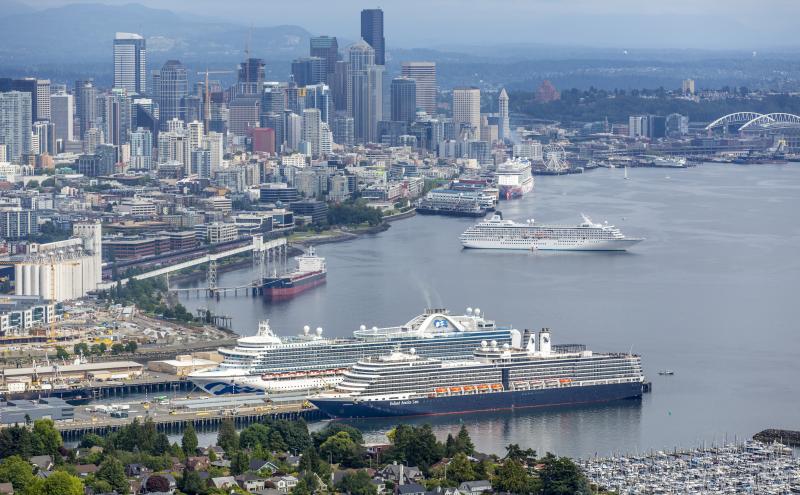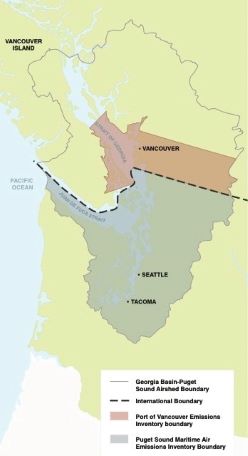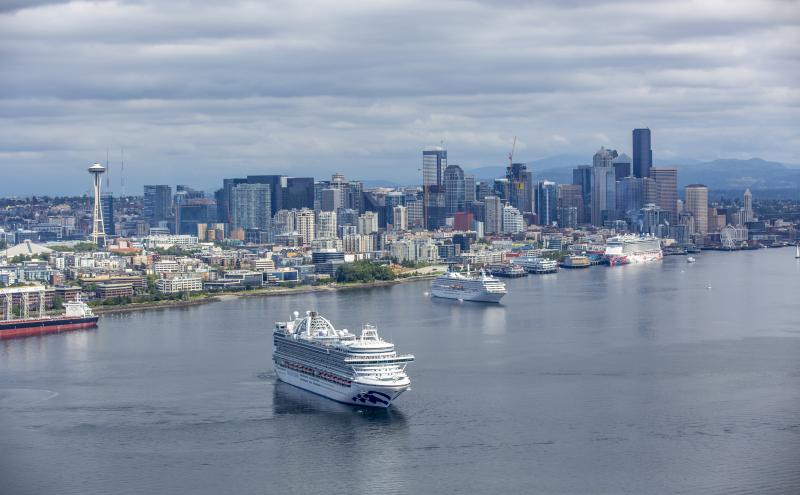
Northwest Ports Clean Air Strategy

The Northwest Ports Clean Air Strategy (Strategy) is a collaborative effort between the Port of Seattle, Port of Tacoma, Northwest Seaport Alliance, and Vancouver Fraser Port Authority in British Columbia (Northwest Ports) to reduce air and greenhouse gas (GHG) emissions from shipping and port operations in the ports' shared airshed.
First adopted in 2008, the Strategy was the first international strategy of its kind in the Port community. The original Strategy sought to encourage environmental action above competition and created a means for the four Northwest Ports to work collectively and voluntarily to reduce air pollution. In 2020, the Northwest Ports renewed the Strategy with a new vision to phase out emissions from seaport-related activities by 2050, supporting cleaner air for our local communities and fulfilling our shared responsibility to help limit global temperature rise to 1.5°C.
Northwest Ports Clean Air Strategy documents:
- Northwest Ports Clean Air Strategy - 2020 (full document)
- Northwest Ports Clean Air Strategy - 2020 (one-page summary)
- English: Northwest Ports Clean Air Strategy - 2020
- Español/Spanish: Estrategia de Aire Limpio de Los Puertos del Noroeste
- Việt/Vietnamese: Chiến lược làm sạch không khí các cảng Tây Bắc
- គុណនាម/Khmer: យុទ្ធសាស្ត្រខ្យល់ស្អាត កំពង់ផែភាគពាយ័ព្យ
- Soomaali/Somali: Istiraatijiga Nadiif Ahaanta Hawada Dekedaha Woqooyi Galbeed
- Northwest Ports Clean Air Strategy - 2013 Update
- Northwest Ports Clean Air Strategy - 2008
Progress to Reduce Air and GHG Emissions
The strategy covers six sectors of port activity: oceangoing vessels, cargo-handling equipment, trucks, harbor vessels, rail, and port administration and tenant facilities. Since the Strategy's inception, the Northwest Ports have worked in collaboration with several agencies to reduce emissions. Partners include the U.S. Environmental Protection Agency, Washington State Department of Ecology, Puget Sound Clean Air Agency, Environment Canada, British Columbia Ministry of Environment and Climate Change Strategy, and Metro Vancouver.
The Strategy has achieved significant results after over a decade of implementation. The 2013 Strategy set targets to reduce diesel particulate matter (DPM) and GHG emissions per metric ton of cargo by 80 percent and 15 percent, respectively, relative to 2005 levels. The Northwest Ports achieved both targets four years early as of the 2016 Puget Sound Maritime emissions Inventory. The reductions can be attributed to changes in international, national, and provincial regulations, industry action, and port policies and programs to accelerate the turnover of older equipment and use cleaner fuels.
During this period, total emissions of DPM declined 75 percent, while total emissions of GHGs combined across the four ports increased by almost five percent. This increase can be attributed to growth in the cargo movement outpacing the reduction of GHG emissions. In addition to these targets, several objectives were set within each of the sectors in the 2013 Strategy. Progress toward these objectives continues to be reported on and published in annual Implementation Reports. Air and GHG emissions from each sector are measured every five years in the Puget Sound Maritime Air Emissions Inventory.
Puget Sound Maritime Air Emissions Inventory reports: 2005, 2011, 2016
Northwest Ports Clean Air Strategy Implementation reports: 2008, 2009, 2010, 2011, 2012, 2013, 2014, 2015, 2016, 2017, 2018, 2019, 2020, 2021, 2022
2020 Strategy Renewal: Northwest Ports to Phase Out Emissions by 2050
In 2018, the Northwest Ports began the process to develop a renewed Strategy that set objectives and actions beyond 2020. Building upon the partnerships and successes of the last decade, the renewal recognizes the urgency of the climate crisis and the need to reduce local air pollution in areas where air quality is poor. In the 2020 Strategy, the Northwest Ports commit to an ambitious new vision to phase out seaport related air and GHG emissions and transition to zero-emission operations within each sector by 2050.
Updated vision: Phase out emissions from seaport-related activities by 2050, supporting cleaner air for our local communities and fulfilling our responsibility to help limit global temperature rise to 1.5 degrees Celsius.
In developing the 2020 Strategy, the Northwest Ports sought input from community members, environmental health advocacy organizations, industry representatives, and Tribal, federal, state, and local government agencies in a three-part engagement process. Feedback shared through in-person and virtual workshops, meetings, briefings, and written comments shaped the vision and objectives and helped the Northwest Ports define both the Strategy and implementation actions.
- Engagement Part I Summary: Project Kickoff, Visioning (Summer 2019)
- Engagement Part II Summary: Sector-specific workshops and defining conditions for success, objectives, metrics (Spring 2020)
- Engagement Part III Summary: Review full draft 2020 Strategy (Fall 2020)
Implementation at Port of Seattle
The Northwest Ports will each develop port-specific implementation plans to implement the Strategy vision and objectives in their own lines of business and will continue to report annually on the progress.
Charting the Course to Zero: Port of Seattle's Maritime Climate and Air Action Plan (the MCAAP) is Port of Seattle's implementation plan for the Northwest Ports Clean Air Strategy. For more information on the Port's implementation plan and to view the draft plan check out the MCAAP webpage. For information on how to get involved, check out the Strategy implementation webpage.




